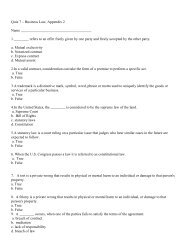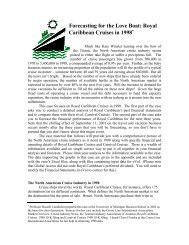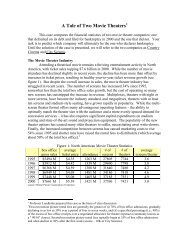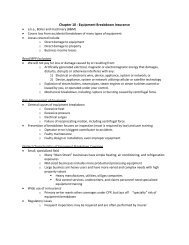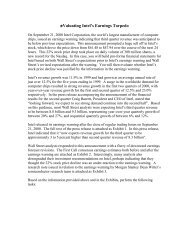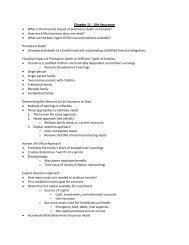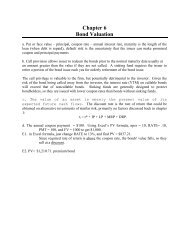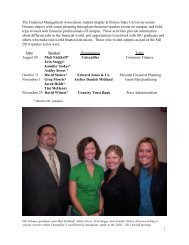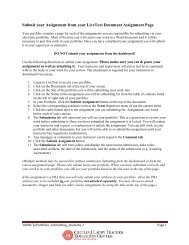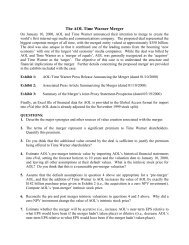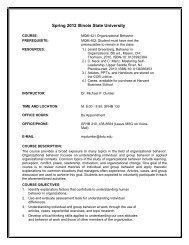Evaluating a Firm's External Environment - Illinois State University
Evaluating a Firm's External Environment - Illinois State University
Evaluating a Firm's External Environment - Illinois State University
You also want an ePaper? Increase the reach of your titles
YUMPU automatically turns print PDFs into web optimized ePapers that Google loves.
M02_BARN4586_03_SE_C02.qxd 7/1/09 7:34 AM Page 41<br />
Chapter 2: <strong>Evaluating</strong> a Firm’s <strong>External</strong> <strong>Environment</strong> 41<br />
Proprietary technology. When incumbent firms have secret or patented technology<br />
that reduces their costs below the costs of potential entrants, potential<br />
entrants must develop substitute technologies to compete. The cost of<br />
developing this technology can act as a barrier to entry.<br />
Managerial know-how. When incumbent firms have taken-for-granted<br />
knowledge, skills, and information that take years to develop and that is<br />
not possessed by potential entrants. The cost of developing this know-how<br />
can act as a barrier to entry.<br />
Favorable access to raw materials. When incumbent firms have low-cost access<br />
to critical raw materials not enjoyed by potential entrants. The cost of<br />
gaining similar access can act as a barrier to entry.<br />
Learning-curve cost advantages. When the cumulative volume of production of<br />
incumbent firms gives them cost advantages not enjoyed by potential<br />
entrants. These cost disadvantages of potential entrants can act as a barrier to<br />
entry.<br />
TABLE 2.2 Sources of Cost<br />
Advantage, Independent of<br />
Scale,That Can Act as Barriers to<br />
Entry<br />
example, in the 1990s Eastman Kodak had to pay Polaroid $910 million and Intel<br />
had to pay Digital $700 million for violating patents. More recently, Roche<br />
Holding had to pay Igen International $505 million and Genentech had to pay<br />
City of Hope National Medical Center $500 million for violating patents. Eolas<br />
had to pay $521 million for infringing a Microsoft patent, and Gateway had to pay<br />
$250 million for violating an Intergraph patent.<br />
Indeed, in the United <strong>State</strong>s at least 20 firms have had to pay some other firm<br />
over $100 million for violating the other firm’s patents. And this does not include<br />
the numerous patent infringement suits that are settled out of court, suits that<br />
involve literally billions of dollars exchanging hands. Obviously, if an industry<br />
has several firms with proprietary technologies, these technologies can substantially<br />
increase the cost of entry into that industry. 20<br />
The number of patent infringement suits filed in the United <strong>State</strong>s has<br />
increased every year for the past 15 years. The number of such suits in 1991 was<br />
1,171; the number in 2004 (the last year for which complete data are available)<br />
was 3,075. Since 1994, the median damage award in a patent infringement suit has<br />
been $8 million. Currently, 60 percent of the patent infringement suits filed lead to<br />
financial compensation. Patent suits are distributed across numerous industries,<br />
including electronic equipment (14.6 percent), chemicals (14 percent), measuring<br />
instruments (13.4 percent), computer equipment (12.2 percent), and business services<br />
(9.8 percent). 21<br />
Managerial Know-How. Even more important than technology per se as a barrier to<br />
entry is the managerial know-how built up by incumbent firms over their<br />
history. 22 Managerial know-how is the often-taken-for-granted knowledge and<br />
information that are needed to compete in an industry on a day-to-day basis. 23<br />
Know-how includes information that it has taken years, sometimes decades, for a<br />
firm to accumulate that enables it to interact with customers and suppliers, to be<br />
innovative and creative, to manufacture quality products, and so forth. Typically,<br />
new entrants will not have access to this know-now, and it will often be costly for<br />
them to build it quickly.<br />
One industry where this kind of know-how is a very important barrier to<br />
entry is the pharmaceutical industry. Success in this industry depends on having



